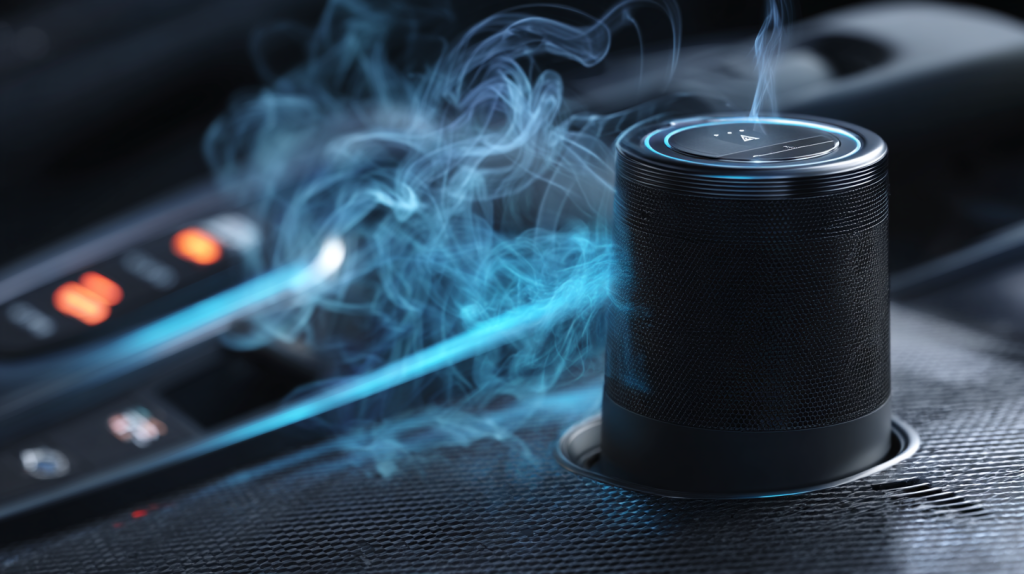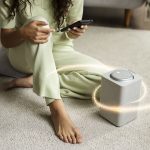Car interiors are prone to lingering odors from food spills, pets, smoke, or mildew. Many drivers wonder how an ionizer works to remove smells in a car and turn to air purifiers to address these odors. Ionizing models are a popular choice, but do they actually work? Let’s explore the science behind odor ionizers and their effectiveness against odors.
How does and ionizer work to remove smell in car?
Ionizing purifiers, or odor ionizers, release charged particles (ions) into the air. These ions attach to airborne pollutants, such as dust, pollen, or smoke particles, giving them an electrical charge. The process involves two key outcomes:
- Clumping: Charged particles aggregate, become heavy, and settle on surfaces.
- Electrostatic Capture: Particles stick to a charged plate inside the purifier (if equipped).
Key Limitation: Ions target particulate pollutants but do not neutralize gaseous odors like VOCs.
Types of Car Odors: Particulate vs. Gaseous
Understanding odor sources is critical for effective purification:
| Odor Type | Description | Examples |
|---|---|---|
| Particulate-Based | Caused by physical particles in the air | Smoke, pet dander, mold spores |
| Gaseous | Result from VOCs or gases | Rotting food, gasoline, cigarette VOCs |
Odor ionizers primarily tackle particulate odors but struggle with gaseous pollutants.
Effectiveness Against Common Car Odors
The table below evaluates ionizer performance for specific smells:
| Odor Source | Particulate Component | Gaseous Component | Ionizer Effectiveness |
|---|---|---|---|
| Tobacco Smoke | Ash, tar particles | Nicotine, tar residue | Reduces particulates; gases remain |
| Food/Spills | Mold spores (if present) | Rotting food VOCs | Minimal impact on gases |
| Pet Odors | Dander, fur | Urine/fecal gases | Reduces dander; gases persist |
| Mildew/Mold | Airborne spores | Moisture-related VOCs | Reduces spores; doesn’t fix mold |

Ionizers vs. Other Air Purification Technologies
Compare technologies to determine the best solution:
| Technology | Target Pollutants | Pros | Cons |
|---|---|---|---|
| Ionizers | Particulates | Quiet, low energy | Poor for gases; may produce ozone |
| HEPA Filters | Particles (99.97%) | Highly effective for particulates | No gas removal; requires airflow |
| Activated Carbon | VOCs, gases | Neutralizes chemical odors | Needs frequent replacement |
| Ozone Generators | VOCs, odors | Strong odor elimination | Health risks; banned in some areas |
Hybrid Tip: Combine ionizers with carbon filters for comprehensive odor removal.
Pros and Cons of Ionizing Car Air Purifiers
| Pros | Cons |
|---|---|
| Quiet operation (no fans) | Limited impact on gaseous odors |
| Low energy consumption | Settled particles require manual cleaning |
| Reduces dust, smoke, and allergens | Potential ozone byproduct (check safety) |
Safety Considerations: The Ozone Question
Caution: Some ionizers produce ozone, a lung irritant.
- Opt for ozone-free models or devices with CARB certification.
- The EPA recommends avoiding ozone-generating purifiers in enclosed spaces.
Do They Work? The Verdict
Ionizers provide partial odor control. For best results:
- Pair with activated carbon filters for gases.
- Clean spills and mold promptly.
- Maintain the purifier (e.g., clean collection plates).
Final Thoughts
Ionizers effectively reduce particulate odors, such as smoke and dander, but they don’t eliminate gaseous odors. For optimal results, it’s best to combine ionizers with carbon filters and ensure regular cleaning of the device. Additionally, prioritize ozone-free models for safety. By understanding the science and limitations of an odor ionizer, you can make an informed choice, ensuring a fresher and cleaner car interior.


